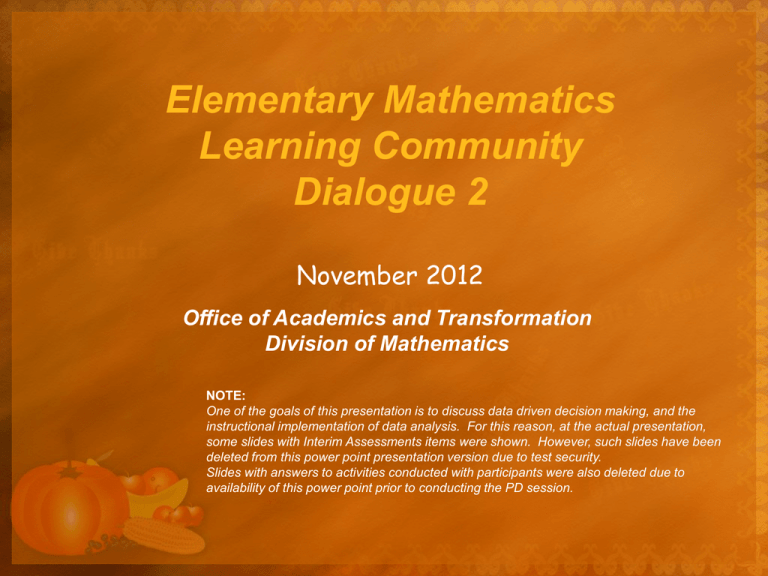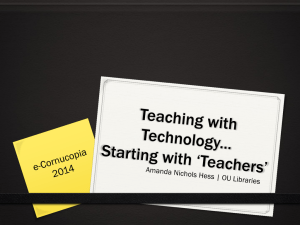Elementary Mathematics Learning Community Dialogue 2
advertisement

Elementary Mathematics Learning Community Dialogue 2 November 2012 Office of Academics and Transformation Division of Mathematics NOTE: One of the goals of this presentation is to discuss data driven decision making, and the instructional implementation of data analysis. For this reason, at the actual presentation, some slides with Interim Assessments items were shown. However, such slides have been deleted from this power point presentation version due to test security. Slides with answers to activities conducted with participants were also deleted due to availability of this power point prior to conducting the PD session. AGENDA • • • • • Puzzles, Patterns, Learning in Context What is Problem Solving? Metacognitive Behaviors What Do Good Problem Solvers Do? Effective Instructional Procedures for Teaching Math Problem Solving • QMBA Item Analysis (K-2) • Will CCSSM Matter in Ten Years? • Instructional Coaching Cycle Puzzles, Patterns, Learning in Context • Maria saved $24. She saved 3 times as much as Wayne. Two interpretations of Division Thomas H. Parker and Scott Baldridge When we know the original amount and the number of parts, we use partitive (sharing) division to find the size of each part. We use “division to find the number in each group.” Thomas H. Parker and Scott Baldridge When we know the original amount and the size or measure of one part, we use measurement division to find the number of parts. Sarah made 210 cupcakes. She put them into boxes of 10 each. How many boxes of cupcakes were there? We use “division to find the number of groups.” Thomas H. Parker and Scott Baldridge Partitive or Measurement Divison? Measurement Division Partitive Division Millie has 15 cookies. She puts 3 cookies in each bag. How many bags can she fill? Millie has 5 bags of cookies. Altogether she has15 cookies. There are the same number of cookies in each bag. How many cookies are in each bag? Adapted from Cognitively Guided Instruction, University of Wisconsin-Madison, 1992 Partitive or Measurement Divison? Measurement Division Partitive Division Manuel has 24 pencils. They are packed 6 pencils to a box. How many boxes of pencils does he have? Manuel has 6 boxes of pencils with the same number of pencils in each box. Altogether, he has 24 pencils. How many pencils are in each box? Adapted from Cognitively Guided Instruction, University of Wisconsin-Madison, 1992 Einstein is quoted to have said : “if he had one hour to save the world he would spend fifty-five minutes defining the problem and only five minutes finding the solution”. What is Problem Solving? Problem solving is a process and skill that you develop over time to be used when needing to solve immediate problems in order to achieve a goal. University of South Australia New Research • You're at a big group dinner and it's time to pay up, to divide the total and multiply a certain percentage for the tip. How many people tense up and say something like, "Oh, I'm so bad at math"? • Fear of math is everywhere - in the adult world where there aren't official pop quizzes, and in schools where the next generation of scientific problem-solvers are struggling with homework. • Researchers report in a new study in the journal PLOS. One that this anxiety about mathematics triggers the same brain activity that's linked with the physical sensation of pain. Elizabeth Landau - CNN.com Health Writer/Producer Metacognition • Several research studies have concluded that metacognitive processes improve problem solving performance. (Artzt & Armour-Thomas, 1992; Goos & Galbraith, 1996; Kramarski & Mevarech, 1997) • Metacognition is also believed to help students develop confidence to attempt authentic tasks (Kramarski, Mevarech, & Arami, 2002), and to help students overcome obstacles that arise during the problemsolving process (Goos, 1997; Pugalee, 2001; Stillman & Galbraith, 1998). Cognitive and Metacognitive Aspects of Mathematical Problem Solving: An Emerging Model by Asmamaw Yimer and Nerida F. Ellerton What is metacognition? Metacognition is defined as "cognition about cognition", or "knowing about knowing." It can take many forms; it includes knowledge about when and how to use particular strategies for learning or for problem solving. Wikipedia Categories of Cognitive and Metacognitive Behaviors: 1. Engagement: Initial confrontation and making sense of the problem. 2. Transformation-Formulation: Transformation of initial engagements to exploratory and formal plans. 3. Implementation: A monitored acting on plans and explorations. 4. Evaluation: Passing judgments on the appropriateness of plans, actions, and solutions to the problem. 5. Internalization: Reflecting on the degree of intimacy and other qualities of the solution process. Cognitive and Metacognitive Aspects of Mathematical Problem Solving: An Emerging Model by Asmamaw Yimer and Nerida F. Ellerton Problem solving and Metacognition “Without metacognitive monitoring, students are less likely to take one of the many paths available to them, and almost certainly are less likely to arrive at an elegant mathematical solution.” Cognitive and Metacognitive Aspects of Mathematical Problem Solving: An Emerging Model by Asmamaw Yimer and Nerida F. Ellerton Problem Solving Mathematical problem solving is a complex cognitive activity involving a number of processes and strategies. Problem solving has two stages: 1. problem representation 2. problem execution Successful problem solving is not possible without first representing the problem appropriately. Appropriate problem representation indicates that the problem solver has understood the problem and serves to guide the student toward the solution plan. Students who have difficulty representing math problems will have difficulty solving them. Math Problem Solving for Upper Elementary Students with Disabilities by Marjorie Montague, PhD Visualization A powerful problem-solving strategy… Math Problem Solving for Upper Elementary Students with Disabilities by Marjorie Montague, PhD Visualization Problem Solving 1. READ the problem for understanding. 2. PARAPHRASE the problem by putting it into their own words. 3. VISUALIZE or draw a picture or diagram. 4. HYPOTHESIZE by thinking about logical solutions. 5. ESTIMATE or predict the answer. 6. COMPUTE. 7. CHECK. Math Problem Solving for Upper Elementary Students with Disabilities by Marjorie Montague, PhD Instructional Procedures The content of math problem solving instruction are the cognitive processes and metacognitive strategies that good problem solvers use to solve mathematical problems. ~Marjorie Montague Math Problem Solving for Upper Elementary Students with Disabilities by Marjorie Montague, PhD Problem Solving Effective instructional procedures for teaching math problem solving! Math Problem Solving for Upper Elementary Students with Disabilities by Marjorie Montague, PhD Instructional Procedures Explicit Instruction Sequencing and Segmenting Drill-repetition and Practice-review Directed Questioning and Responses Control Difficulty or Processing Demands of the Task Technology Group Instruction Peer Involvement Strategy Cues Verbal Rehearsal Process Modeling Visualization Role Reversal Performance Feedback Distributed Practice Mastery Learning Math Problem Solving for Upper Elementary Students with Disabilities by Marjorie Montague, PhD Part A A restaurant makes a special seasoning for all its grilled vegetables. Here is how the ingredients are mixed: 1/2 of the mixture is salt 1/4 of the mixture is pepper 1/8 of the mixture is garlic powder 1/8 of the mixture is onion powder When the ingredients are mixed in the same ratio as shown above, every batch of seasoning tastes the same. Study the measurements for each batch in the table. Fill in the blanks so that every batch will taste the same. The Charles A. Dana Center at the University of Texas at Austin and Agile Mind, Inc. Answers The Charles A. Dana Center at the University of Texas at Austin and Agile Mind, Inc. Part B A restaurant makes a special seasoning for all its grilled vegetables. Here is how the ingredients are mixed: 1/2 of the mixture is salt 1/4 of the mixture is pepper 1/8 of the mixture is garlic powder 1/8 of the mixture is onion powder The restaurant mixes a 12-cup batch of the mixture every week. How many cups of each ingredient do they use in the mixture each week? The Charles A. Dana Center at the University of Texas at Austin and Agile Mind, Inc. Answers The Charles A. Dana Center at the University of Texas at Austin and Agile Mind, Inc. Interim Assessments Edusoft Reports Performance Band Report (Question Groups) Item Analysis per Period 2012-2013 Benchmark Analysis Performance Band Report Item Analysis Edusoft Guides • Guide to Creating Interim Assessment Reports by SubGroups (All, Ethnicity, Ed Program, and ELL) • Guide to Performance Band, Item Analysis, and Item Response Reports • Edusoft Sub-Group (Demographic) Selection Item Specifications Benchmark Clarifications Explain how the achievement of the benchmark will be demonstrated by students for each specific item type. In other words, the clarification statements explain what the student will do when responding to questions of each type. Item Specifications Content Limits Define the range of content knowledge and degree of difficulty that should be assessed in the items for the benchmark. Benchmark content limits are to be used in conjunction with the General Content Limits identified for each grade level in the Specifications. The content limits defined in the Individual Benchmark Specifications section may be an expansion or further restriction of the General Content Limits by Grade Level specified earlier in the Specifications. Item Specifications Item Specifications • MA.4.A.6.6 QMBA: Grades K – 2 (CCSSM) Performance Band Reports Item Analysis Only three questions above 50% correct! What are the Instructional Implications? Re-teaching MA.4.A.6.6 • Resources • Instructional Strategies • Differentiated Instruction Re-teaching MA.4.A.6.6 GO Math! Resources About Mini Bats and How to Use Them Interim assessments are a formative assessment that informs whether the student attained an understanding of the standards taught in the quarter. Fall Interim assesses Quarter 1 concepts. Winter Interim assesses Quarter 2 concepts. Mini BATs are mini benchmark assessments that assess whether, after remediation, a student has gained an understanding of the concepts of a benchmark he/she showed weakness on the Interim. Quarter 1 Mini BATs- are used during Quarter 2 based on remediation needed as per Fall Interim Assessment results. Quarter 2 Mini BATs- are used during Quarter 3 based on remediation needed as per Winter Interim Assessment results. Quarter 3 Mini BATs- can be used either in Quarter 3 or 4. Quarter 4 Mini BATs- can be used in Quarter 4. Other Assessment Resources SAT-10 Dailies The SAT-10 Dailies is an instructional tool developed to help teachers reinforce instruction on basic mathematics concepts taught to students, using items that also reflect the content and process clusters measured by the Stanford Achievement Test-10. The daily practice provides opportunities for both multiple-choice and student constructed responses during the school year leading up to the week of testing. Suggested Usage: • Dailies should be used each day of the week, only one practice sheet per day. • Dailies are recommended to be used during the transition time into the mathematics instructional block; preferably during the first five minutes of class. During such time, students answer the questions in 3 minutes or less and the teacher briefly reviews responses. • Effort grades may be assigned. Teachers should not assign a grade to Dailies since they do not represent the students’ understanding of the concept(s) of the day’s lesson. Will CCSSM Matter in Ten Years? Will CCSSM Matter in Ten Years? During which part of the day could we work as a grade-level team to discuss the Standards for Mathematical Practice and develop our understanding? How can we work collaboratively to implement the Standards for Mathematical Practice into our lesson designs? Which initial tasks, activities, or formative assessments can we use? What student behaviors might define the Standards for Mathematical Practice? Given a specific CCSSM Content Standard. Examine the meaning of the Standard, and analyze and interpret new or unfamiliar content. How can we deepen our understanding of the math? NCTM Vol. 19, No. 2 | teaching children mathematics • September 2012 MACC.1.OA.4.7: Understand the meaning of the equal sign, and determine if equations involving addition and subtraction are true or false. For example, which of the following equations are true and which are false? 6 = 6, 7 = 8 – 1, 5 + 2 = 2 + 5, 4 + 1 = 5 + 2. MACC.1.OA.4.7: Mathematically proficient students communicate precisely by engaging in discussion about their reasoning using appropriate mathematical language. The terms students should learn to use with increasing precision with this cluster are: equations, equal, the same amount/quantity as, true, false Unpacking What do these standards mean a child will know and be able to do? Unpacking In order to determine whether an equation is true or false, First Grade students must first understand the meaning of the equal sign. This is developed as students in Kindergarten and First Grade solve numerous joining and separating situations with mathematical tools, rather than symbols. Once the concepts of joining, separating, and “the same amount/quantity as” are developed concretely, First Graders are ready to connect these experiences to the corresponding symbols (+, -, =). Thus, students learn that the equal sign does not mean “the answer comes next”, but that the symbol signifies an equivalent relationship that the left side ‘has the same value as’ the right side of the equation. Unpacking When students understand that an equation needs to “balance”, with equal quantities on both sides of the equal sign, they understand various representations of equations, such as: • an operation on the left side of the equal sign and the answer on the right side (5 + 8 = 13) • an operation on the right side of the equal sign and the answer on the left side (13 = 5 + 8) • numbers on both sides of the equal sign (6 = 6) • operations on both sides of the equal sign (5 + 2 = 4 + 3). Once students understand the meaning of the equal sign, they are able to determine if an equation is true (9 = 9) or false (9 = 8). MACC.3.NF.1.1: Understand a fraction 1/b as the quantity formed by 1 part when a whole is partitioned into b equal parts; understand a fraction a/b as the quantity formed by a parts of size 1/b. MACC.3.NF.1.1: Mathematically proficient students communicate precisely by engaging in discussion about their reasoning using appropriate mathematical language. The terms students should learn to use with increasing precision with this cluster are: partition(ed), equal parts, fraction, equal distance ( intervals), equivalent, equivalence, reasonable, denominator, numerator, comparison, compare, ‹, ›, = , justify Unpacking What do these standards mean a child will know and be able to do? Unpacking This standard refers to the sharing of a whole being partitioned. Fraction models in third grade include only area (parts of a whole) models (circles, rectangles, squares) and number lines. Set models (parts of a group) are not addressed in Third Grade. In 3.NF.1.1 students start with unit fractions (fractions with numerator 1), which are formed by partitioning a whole into equal parts and reasoning about one part of the whole, e.g., if a whole is partitioned into 4 equal parts then each part is ¼ of the whole, and 4 copies of that part make the whole. Next, students build fractions from unit fractions, seeing the numerator 3 of ¾ as saying that ¾ is the quantity you get by putting 3 of the ¼ ’s together. There is no need to introduce “improper fractions" initially. Unpacking (Progressions for the CCSSM; Number and Operation – Fractions, CCSS Writing Team, August 2011, page 2) Unpacking (Progressions for the CCSSM; Number and Operation – Fractions, CCSS Writing Team, August 2011, page 3) MACC.5.NF.2.4a: Interpret the product (a/b) × q as a parts of a partition of q into b equal parts; equivalently, as the result of a sequence of operations a × q ÷ b. For example, use a visual fraction model to show (2/3) × 4 = 8/3, and create a story context for this equation. Do the same with (2/3) × (4/5) = 8/15. (In general, (a/b) × (c/d) = ac/bd.) Coaching Cycle Instructional Coaching Instructional coaches are onsite professional developers who teach educators how to use proven teaching methods. They employ a variety of professional development procedures to foster widespread, high-quality implementation of interventions, providing “on-the-job learning.” Instructional coaches take a partnership approach, and thus they respect teachers’ professionalism and focus their efforts on conversations that lead to creative, practical application of research-based practices. Instructional coaches see themselves as equal partners with teachers in the complex and richly rewarding work of teaching students. Instructional coaches work in partnerships to accelerate teachers’ professional learning through mutually enriching, healthy relationships. Instructional coaches are colleagues, friends, and confidants who listen with care and share valuable information with teachers at the time when teachers most need it. Kansas Coaching Project Maria Teresa Diaz-Gonzalez, District Instructional Supervisor mtdiaz@dadeschools.net 305-995-2763 Maria Campitelli, District Curriculum Support Specialist mcampitelli@dadeschools.net 305-995-2927 Isis Casares, District Curriculum Support Specialist isis17casares@dadeschools.net 305-995-7280







